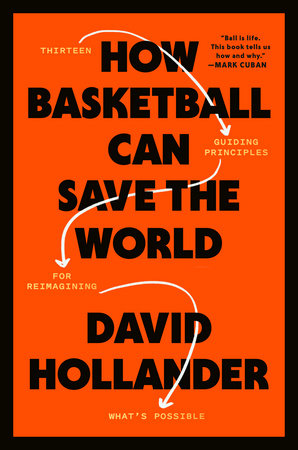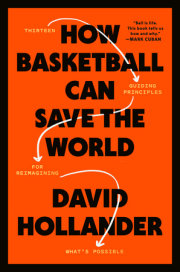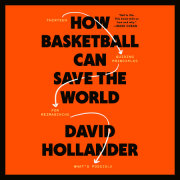1
CooperationYou have to give everybody space to be their best; to operate. The more you play, the more you just have a feel. I understand the types of passes a teammate can make—how hard or how fast—and where I need to be in order to receive it. I understand if Breanna Stewart has the ball, I need to give her space, let her operate, do what she does best. If somebody else has the ball, maybe I need to go get it, because they’re not a ball-handler, or we’re being pressed, and I need to close down that space. If you’re too crowded, you know you’re going to hurt your teammate. It’s fascinating when I think of myself on thvwe court in that way. Backpedaling my way out, sprinting over here or coming over there. There’s definitely a spatial negotiation constantly happening and it’s always for the betterment of the team. Same thing when I’m out in public: I know exactly how far you need to be and I know exactly where I’m going.—Sue Bird, four-time WNBA champion, five-time Olympic gold medalist, five-time Russian National League champion, five-time EuroLeague champion, two-time NCAA champion, New York State high school championI can still recall how I snapped my fingers and shouted, ‘I’ve got it!’ ” That was James Naismith’s eureka moment, for himself and for all of us. His premise was basic: “If he can’t run with the ball, we don’t have to tackle.”
Naismith knew that the boys in his class at Springfield College only liked games that involved tackling and rough physical contact. Those students had already chased two previous Springfield College class instructors out of their jobs for trying to introduce nonviolent recreation. What would hold the attention of these “incorrigible” ruffians? To get them to cooperate, Naismith offered a vehicle of cooperation. Incredibly, during a single night of hard thinking by the lamplight at his desk, he wrote the 13 original rules of basketball.
If the players of his new game couldn’t run with the ball, then what?
“The next step,” thought Naismith, “was to see exactly what he could do with it.” The solution? Pass to a teammate.
This was Naismith’s quantum leap. He eliminated ball-movement-by-running and replaced it with passing, completely eschewing the entrenched, one-dimensional principle of individuals running with a ball toward a goal, trying to evade or plow through would-be tacklers. This was a profound shift in form and consciousness. Naismith’s new game introduced the core necessity of team cooperation in place of the core worship of the single player versus the world.
If you wanted to advance up the court and score, you had to pass or share the ball. That was his first rule. His second rule radically expanded the scope of cooperation: Any player can pass in any direction—forward, backward, laterally—to any other player. Naismith delimited cooperation in form, direction, and variety. “In my mind,” he said, “I began to play a game and visualize the movements of the players.”
Naismith posted his 13 rules on the gymnasium bulletin board the next morning, explicitly stating in rule 5 the nonviolent intention of the game: “No shouldering, holding, pushing, tripping, or striking in any way the person of an opponent shall be allowed.”
It didn’t start off exactly as he drew it, though. “The boys began tackling, kicking, and punching in the clinches,” he recalled in Basketball: Origin and Development. “They ended up in a free-for-all in the middle of the gym floor. Before I could pull them apart, one boy was knocked out, several of them had black eyes, and one had a dislocated shoulder. It certainly was murder.” But each time a brawl broke out, Naismith patiently redirected them. And sometime that afternoon, in that YMCA gym in Springfield, Massachusetts, it happened: The boys took to the game and its rules so entirely that they didn’t want to leave the court to go to their next class.
James Naismith created a new game that replaced individual possession with interdependent cooperation as its basis and foresaw how the game would prove utterly compelling because of it. Basketball felt good, and he knew it. And his students knew it. And if you have played the game, you know it, too.
It’s not just that the value of cooperation in basketball is intrinsic and self-evident, it’s also enjoyable. Basketball also provides fundamental cooperative pleasures like the give-and-go or the pick-and-roll. Or the perfectly executed switch on defense to defend against the pick. Or a rotation to help on defense—cooperatively named “help defense”—where you leave your man to help another.
Or the ultimate cooperative-basketball transcendental meditation: the three-person weave. Pass, cut, catch. Pass, cut, catch. Again and again and again. The three-person weave patterns like a figure eight, but it’s more accurate to think of it as an infinity symbol. As if the way to live infinitely is to let go of the ball, then come back around to get it again. In the human utopia of the three-person weave, you trust in seamless, continuous, rhythmic cooperation. You know the ball is coming back even as you let it go. It is a rapturous exercise.
How deep in the human psyche can this cooperative joy be found? Many take it back to 1200 bc Mesoamericans—Mayans and Aztecs—who participated in a ritualistic “ballgame” that looked an awful lot like basketball. On a sunken court, with elevated circular hoops at each end, the game was played by teams who advanced a bouncy solid rubber ball through repetitive, cooperative, circular team movements. These circular movements were meant to honor the coming harvest; the patterns symbolized the changing seasons, the sky and the underworld, life and death, harmonizing with the spinning earth, becoming one with the vast and endless cosmos.
For the Mesoamericans, this ballgame was about cooperating with the universe—not declaring dominion or separateness from it, not plundering it, but, through the game, sanctifying their necessary symbiosis with it. This basic principle of cooperation may have even deeper roots, predating humanity entirely. Suzanne Simard, a University of British Columbia scientist, has gone a long way in demonstrating that trees—yes, trees—cooperate, especially when they are part of a team: the forest. They communicate, reciprocate, show selflessness, and share resources with other trees. Trees give-and-go, pick-and-roll, and shore up each other’s weak sides through active, independent mycorrhizal networks. For the sake of the forest, trees cooperate.
Naismith so embedded cooperation into his game that even the greatest individual players must embrace the principle in thought and action in order to reach the highest of achievements. Phil Jackson, who amassed eleven rings as an NBA coach and player, wrote in his basketball bestseller Sacred Hoops, “Good teams become great ones when teammates trust each other enough to surrender the Me for the We.” This was true even for Michael Jordan. There would have been no first dance, or last dance, if he hadn’t learned to cooperate with Scottie Pippen.
Players UnderstandBill Russell is the most successful individual player in NBA history in terms of championship rings. He won eleven championships in thirteen seasons, far more than any other player. Again and again, he famously bested the Goliath of his day, Wilt Chamberlain. Years later another Hall of Famer, Sonny Hill, asked him on a sports radio show how he might stop Shaquille O’Neal, who was at the time (ca. 1994) seemingly undefendable because of his physical dominance. There was a brief silence, then Russell answered. “I wouldn’t stop him. My team would.”
Russell could not conceive of himself without the cooperation of his teammates. When he paused before answering, it was likely him thinking, “Me stop Shaq? . . . Wait, the me part here does not compute.” Any question about a basketball stratagem, for Russell, could only be answered from a cooperative team standpoint. As soon as he thought of himself doing something on a basketball court, he instantaneously thought of the other four players on the floor, and what they would be doing in concert with him. Russell was known to believe so strongly in the basketball cooperative that he consistently resisted the notion of being named to Halls of Fame, All-Star teams, or winning MVP awards on a variety of “it’s not about me” grounds.
Another player who became a modern-era espouser of the cooperative style of play was Bill Bradley, who, along with being a two-time NBA champion, was also a Rhodes Scholar and a US senator. In “
A Sense of Where You Are,” future Pulitzer Prize–winning author John McPhee observed Bradley as an All-American college basketball player at Princeton, already intellectualizing the cooperation principle. “The depth of Bradley’s game is most discernible when he doesn’t have the ball,” noted McPhee. “He always knows where the ball is but is not immediately concerned with getting it.” In other words, Bradley was cooperating.
Copyright © 2023 by David Hollander. All rights reserved. No part of this excerpt may be reproduced or reprinted without permission in writing from the publisher.








